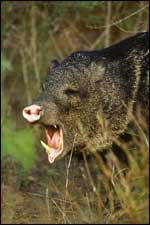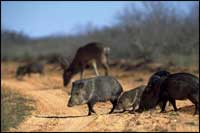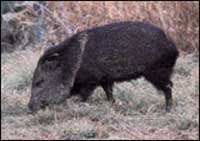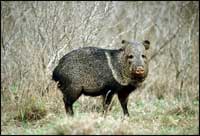Javelinas
Roaming around the western part of the state and the brush country of South Texas is a unique animal known as the javelina, or collared peccary. It has a piglike snout and a stout little body, but these characteristics are not enough to make it a member of the true pig family. True pigs belong to the swine family, which originated in the Eastern Hemisphere, and they were brought to this continent some five hundred years ago by early explorers and settlers. The javelina may have had a similar evolutionary history, but it belongs to the peccary (pECK-ah-ree) family, which developed in the Western Hemisphere. Its hide is covered with grizzled black and grayish hair, and the white band of coarse hair around its neck is the reason it is sometimes called the collared peccary. It has a distinct mane of dark hair that extends along its back from the base of its head to its tail. The bristles in this mane stand up when the javelina is frightened or angry, making the animal look larger and more ferocious.

The javelina usually is not aggressive unless threatened, cornered, or startled, but when aroused, it opens its mouth wide and loudly pops its teeth together.
An adult javelina can reach a weight of fifty-five pounds, stand eighteen to twenty inches tall at the shoulder, and grow to a length of three feet. Males and females cannot be distinguished from each other at a distance since they look alike and can be the same size. Although they share some characteristics, there are noticeable differences that separate the javelina from true pigs. The outer dewclaw is missing on its hind feet, so the javelina has only three hoofed toes there, instead of four like the pig. The female has only two pair of mammary glands for feeding the young, and they are located on the lower part of her abdomen between the back legs. The javelina also has a more complex stomach and fewer teeth than true pigs. Its canine teeth are well developed for cutting and slashing and become dangerous weapons when the javelina is threatened or cornered. When tempers flare and fights erupt between members of the herd, the lightning speed and sharp tusks of the fighting animals often result in torn ears, face cuts, and eventual scars.
Despite their reputation, javelinas are not usually aggressive toward humans and normally retreat unless cornered or startled. However, if the intruding person is accompanied by a dog, the situation can be entirely different. Since dogs resemble coyotes that prey on the young, encounters between javelinas and a dog can be vicious and may result in a dead or badly injured dog. In these battles, the dog is usually the aggressor, chasing or barking at the javelina. When the javelina attacks the dog, it is merely defending itself or its young. Other herd members often come to the aid of the javelina being threatened or chased. Many hunters have had to cut their outings short to take a badly mauled dog to the vet to be sewed up. Occasionally a hunter also is injured while trying to rescue the dog. An aroused javelina makes no distinction between the dog and its master – both appear to be a threat.

About a third of the young, which may be born at any season of the year, are able to survive against weather, hunger, and predators.
Charging javelina stories usually are a result of the herd's habit of scattering in all directions when an alarm is sounded by one of the members. With fifteen or twenty javelinas running in every direction, at least one is bound to be headed for the intruder. Once the herd has been aroused, the members mill around for some time making "whoof, whoof" sounds and occasionally popping their teeth. These loud popping noises sound like two large bones hitting each other at the rate of four times a second. Javelina will continue this aggressive behavior until the cause of alarm is found or until they feel safe again. The person who seeks safety in a tree is "treed" until the animals resume their normal activities. The person can then climb down and slip away.
Studies of javelinas have shown that they tend to remain in family groups, and the resulting herds usually contain five to thirty animals. There seems to be no designated leader; any member of the herd may sound the alarm when danger threatens. Occasionally a male leaves his family group to join another herd, or he may just wander around by himself for a while and eventually return to his original herd. These herds establish definite territories with overlapping edges of about 200 yards. Different herds do not occupy these overlapping areas at the same time. The average size of a home range is about 550 acres. Since the herds are not compatible, the territories are smaller (around 300 acres) in areas with higher populations. Herds seldom travel more than a mile or so during the day, and when range conditions are good, the daily cruising area is as small as half a mile. During drought periods when food is scarce, the animals must cover more area to meet their needs.
The javelina is omnivorous, which means it will eat almost anything available. On most ranges, the prickly pear cactus is more than half of its diet. It seems to pay little attention to the spines, but has been seen dragging a prickly pear pad along the ground, breaking off the larger thorns. The pad, held down by a foot, is then taken between the javelina's long canine teeth. As the animal pulls its head upward, its teeth shred the pad and remove the juice and tender parts from the tough fibers. Prickly pear fruits also are eaten, and the javelina often slashes them with its sharp hooves.

Javelinas are not true pigs, which belong to the swine family, but rather are members of the peccary family.
When located in its range, water holes or stock tanks provide drinking water for the javelina and a place for it to wallow in the mud. If surface water is not available, the animal gets its moisture from plants, such as the prickly pear, which can fulfill most of its water requirements. Since its thorny cactus diet is low in nutrients, the javelina supplements it with mesquite beans, juniper berries, wild grapes, ground cherries, desert gourds, green plants, vines, and grasses. It may uproot a whole century plant to get to the soft bottom parts or root piglike for insects and tender plant parts beneath the ground. However, it seldom digs deeper than a couple of inches. It does not chase down prey or eat snakes as is popularly believed.
While feeding, the javelina makes guttural mutterings. If startled, it will squeal and sometimes emit a strong, pungent odor from a musk gland located on the rump. This gland is exposed when the hair mane is raised, and the odor may serve as a warning to other animals in the herd. Javelina feed mostly at night. In the summer they leave their bedding grounds around sunset and start eating. They rest occasionally throughout the nightly feeding period and return to the bedding grounds before or shortly after sunrise. They do not normally feed during the hot summer daylight hours. It is estimated that they feed for four to six hours daily during the summer.

Javelinas feed on various succulents, such as lechuguilla.
In the winter, they also feed during the night, but are active during the daylight hours. Feeding usually begins in the late afternoon and continues through the night, alternating with rest periods. They bed down several hours before sunrise but resume feeding shortly after daylight. By mid-morning they are ready to return to the bedding grounds. Occasionally the daytime resting period is interrupted with short feeding excursions. It is estimated that they feed thirteen to fifteen hours daily in the winter. Good range conditions will decrease the lengths of time javelina are active. Javelina use the same bedding area for several days, and then the herd moves 200 to 800 yards away. This may serve as a temporary escape from concentrations of fleas in the old bedding area.
There is no particular breeding season, and young can be seen in the herd at any time of the year, although most of them are born in the late spring and early fall. They weigh about a pound at birth and are a reddish or yellowish brown color with a dark stripe down the back. By the time they are two months old, their hair has turned dark. About a third of the young are able to survive against weather, hunger, and predators, mainly coyotes and bobcats. Those which manage to survive join the ranks of these rugged game animals that have managed to adapt in their own unique way to the desolate arid brushlands of South Texas.
Ilo
Hiller
1990 – Javelinas: Introducing Mammals to Young
Naturalists. The Louise
Lindsey Merrick Texas Environment
Series, No. 10, pp. 62-66.
Texas A&M University
Press, College Station.